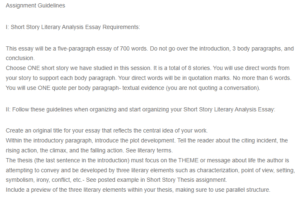An Occurrence at Owl Creek Bridge – Illusion and Reality
Emotions influence how occurrences are perceived. People going through similar circumstances may perceive them differently depending on their emotions. A person undergoing a traumatizing event can view it from a sad and depressing perspective, while another person may view it from a hopeful perspective. The same can be said about freedom, as freedom is far more than just moving the physical body. As Peyton Farquhar hung on the Owl Creek Bridge awaiting his death, numerous emotions passed through his mind. In the bound state, he imagines getting free and, in his freedom, returning home to his wife. Therefore, freedom is an important theme shaping the events of the story. In “An Occurrence at Owl Creek Bridge” by Ambrose Bierce, the theme of freedom can be explored through setting, irony, and imagery.
First, the theme of freedom can be seen through the setting. The what and where in any literature piece are vital in shaping the effect the story has on its readers by raising the question of why. The setting at the story’s beginning presents a man, Farquhar, on a bridge with a cord bounding his wrists and “A rope closely encircled his neck” (Bierce 1). The binding of his hands and the roping of his neck illustrate that his freedom was limited by securing him in place. Additionally, the positioning of sentinels at the bridge’s ends is to keep Farquhar in place, thus continuing to limit his freedom. Furthermore, Farquhar’s falling to death also illustrates the theme of freedom, whereby his spirit departs from his constrained physical body as he crosses over to another world. Also, Farquhar’s mind and thoughts wander freely while being constrained to one place as he imagines escaping his set fate. Accordingly, numerous factors of the setting show how freedom was limited, establishing freedom as a theme.
Second, the theme of freedom can be seen through irony. In the story, Farquhar is shown to escape from his death and begins a journey to see his wife, even getting close enough to embrace her. However, his death nullifies his journey; “Peyton Farquhar was dead” (Bierce 6). The vivid portrayal of his escape and his journey home presented his freedom. Additionally, situational irony is shown when Farquhar goes home and sees his wife smiling back at him, only for him to fall into eternal blackness after seeing a blinding white light. This occurrence manifests the theme of freedom as in losing his life, he gained freedom from the military personnel that constrained him. The movement of the stream also shows the freedom in the slow movement. These aspects illustrate the use of irony in promoting the theme of freedom.
Lastly, the theme of freedom can be seen through the imagery in the short story. The soldier who rode to Farquhar’s home asking for water rode freely and, in his freedom, asked for water from Farquhar. The soldier uses imagery to portray his outfit as gray, implying he was on the same side as Farquhar but instead was a scout of the Federals. This presumed soldier cost Farquhar his freedom as he was constrained on the bridge that the soldier had told him about. Also, the flowing stream manifests freedom through its free movement, elaborated in the slow movement. This portrayal of movement as “swirling water of the stream racing madly beneath his feet” (Bierce 2) shows the use of imagery. Moreover, before declaring his death, Farquhar is presented to be free and journeying toward his home. His movement in the stream and through the forest as he escapes is vividly described. These aspects portray the use of imagery.
In conclusion, in Ambrose Bierce’s short story “An Occurrence at Owl Creek Bridge,” the theme of freedom can be identified through several literary devices. These devices are irony, imagery, and setting. Freedom is illustrated in more than Farquhar’s character but also in his immediate surroundings, including the river and the military personnel. The irony is shown in the difference between Farquhar’s reality and illusion. Imagery is shown in Farquhar’s journey home after he imagines he escaped. The setting is illustrated in Farquhar circumstances on the bridge. All these factors distinguish Farquhar’s story’s illusion from reality.
Works Cited
Bierce, Ambrose. The Occurrence at Owl Creek Bridge, 1890.
ORDER A PLAGIARISM-FREE PAPER HERE
We’ll write everything from scratch
Question

An Occurrence at Owl Creek Bridge – Illusion and Reality
Assignment Guidelines
I: Short Story Literary Analysis Essay Requirements:
This essay will be a five-paragraph essay of 700 words. Do not go over the introduction, 3 body paragraphs, and conclusion.
Choose ONE short story we have studied in this session. It is a total of 8 stories. You will use direct words from your story to support each body paragraph. Your direct words will be in quotation marks. No more than 6 words. You will use ONE quote per body paragraph- textual evidence (you are not quoting a conversation).
II: Follow these guidelines when organizing and start organizing your Short Story Literary Analysis Essay:
Create an original title for your essay that reflects the central idea of your work.
Within the introductory paragraph, introduce the plot development. Tell the reader about the citing incident, the rising action, the climax, and the falling action. See literary terms.
The thesis (the last sentence in the introduction) must focus on the THEME or message about life the author is attempting to convey and be developed by three literary elements such as characterization, point of view, setting, symbolism, irony, conflict, etc.- See posted example in Short Story Thesis assignment.
Include a preview of the three literary elements within your thesis, making sure to use parallel structure.

